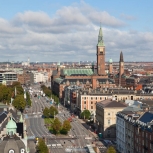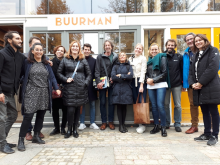
Copenhagen
The capital of Denmark, Copenhagen is the country’s economic and financial centre, as well as being a major seaport. It has a growing population of approximately 550,000 inhabitants and a track record of sustainable long-term urban planning. The so-called ‘Finger Plan’ of 1947 set out the future development of the city along five ‘fingers’ based on suburban S-train rail lines—with green areas between each ‘finger’.
Sustainable development and quality of life are the two themes of Copenhagen’s vision for the future. The prevalence of cycling to work, along with the supply of renewable energy and Combined Heat and Power (CHP) are just two examples. The city has a competitive clean-tech sector and has set itself the target of being carbon neutral by 2025. This is a major challenge given that the area is projected to have a further 100,000 residents by then. The city requires up to 45,000 new homes and the authorities aim to provide space for 2.8 million square metres of new commercial construction. To meet that challenge, the city authorities want Copenhagen to become a test bed for new green solutions that have been developed in partnership with the private sector and research institutions.
The region has a strong, growing economy based on services—notably transport, finance and administration—and an industrial base of high technology companies. Biotech, IT and pharmaceuticals all have business clusters and the city is also home to Copenhagen’s famous Carlsberg brewery. The city works closely with the neighbouring city of Malmö, which is linked by a bridge. The two are often considered a single extended conurbation with a joint population of 2 million.
SOME RELATED NETWORKS
URGE
USER
News
News from our cities and networks – 10 September 2021
Article
23 Action Planning Networks ready for Phase 2!
Article
Transition to circular economy: the ‘’power’’ of the building sector towards better cities
News
23 Action Planning Networks approved!
Article







